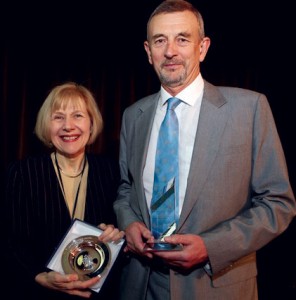
New England in the Fall, and members of the Association of British Neurologists crossed the Atlantic to join the American Neurological Association for their Annual Meeting. The seniority and experience of many who attended was evident in high quality academic lectures and intelligent, clinically relevant discussions. However, it was not a meeting where senior neurologists kept themselves apart; instead they constantly interacted with junior colleagues.
Lectures and symposia
A series of named lectures and well organised symposia showcased the best of current clinical neuroscience research and gave the floor to work developed over a number of years. Alastair Compston (University of Cambridge) gave the Soriano lecture, presenting a body of work in multiple sclerosis stretching back to the 1990’s bringing Alemtuzumab from the theoretical early days, through failures and successes to a phase III trial. He looked to the future of multiple sclerosis work, to find effective treatments with better side effect profiles.
More recent work was presented by Bryan Traynor, (National Institute on Aging) who received a Neurological Scholar Award. He described his ‘eureka’ moment in 2011 on realising that a hexanucleotide repeat expansion in the C9orf72 gene was responsible for a large proportion of familial ALS in Northern Europe. Sydney Cash, (Massachusetts General Hospital, Boston) talked on using EEG, MEG and intracranial electrodes to explore neuronal activity during normal cognition, sleep and seizures. He demonstrated that superior temporal gyrus recordings reveal individual neuronal responses to specific word sounds.

Presentations from two studies of disease modifying drugs targeting the beta-amyloid pathway in Alzheimer’s disease shifted the meeting to another level, bringing the largest audience of the conference. Rachelle Doody (Baylor College of Medicine, Houston) presented modest but encouraging results from Solanezumab in Alzheimer’s disease. She reported an independent study of data provided by Lilly, showing a 1.41 point advantage of Solanezumab over placebo on the ADAS-COG (p=0.009) in mild and moderate Alzheimer’s disease on data pooled from North American and European studies. There was a small effect on decline in daily function (ADCS-ADL) only for mildly affected patients.
By contrast Reisa Sperling (Brigham and Women’s Hospital, Boston) presented disappointing results from Bapineuzumab, showing no effect on clinical scores, and a concerning increased rate of whole brain atrophy in the treatment group.
Both studies will undoubtedly provide insights in to the mechanisms of Alzheimer’s disease and shape future drug studies and trial design, but the general feeling was that we will have to wait a little longer for a truly effective therapy which is ready to take to the clinic.
Special Interest Groups
The breadth of smaller special interest group sessions offered an opportunity to learn about a broad range of topics in neurology. The symposium on health services research was one such session. Strategies to solve inequalities in the American healthcare system formed the basis for the meeting. ‘Can Corporate America Solve Health Disparities’ was a provocative title from Lewis Morgenstein (University of Michigan, Ann Arbor), who discussed the advantages and disadvantages of encouraging companies to provide targeted health promotion for minority groups within their workforce.
A Special Interest Symposium on Sleep Disorders was also informative. Thomas Scammell (Harvard Medical School, Boston), discussed the narcolepsy orexin knockout mice his group uses to study the neurobiology of the disease. These mice respond to rewarding stimuli in the same way as humans with narcolepsy, with increased cataplexy to the rewarding stimuli of running wheels, ‘sociable’ group housing and chocolate. By inducing focal expression of orexin they can identify which brain regions are essential for orexin’s wake-promoting effects.
Lunch workshops
The new interactive lunch workshops certainly sparked debate and controversy. In one workshop continuous EEG monitoring in the ICU was advocated for patients in whom non-convulsive seizures are suspected, as a one hour EEG misses 50% of such cases. This provoked intense discussion on how to facilitate the necessary technical support, staffing and expertise, and how aggressively seizures should be treated if detected.
Faculty Development course
A welcome addition to the programme this year was the excellent daily Faculty Development courses. Strands for Junior and Senior Faculty members and Department Chairs aimed to nurture the careers of academic neurologists at all levels. Although some sessions were more relevant to those seeking NIH funding, the final session entitled ‘Getting Published’ was enlightening. We were treated to behind closed doors insights from Alastair Compston (Editor, Brain) and Stephen Hauser (Editor, Annals of Neurology) who described in detail how the review process functions. Their overriding message was that juniors should strive towards creative, interesting and novel research with relevance to medicine and health.
Art, culture and the city
A display of brain inspired art provided a splash of colour to the meeting. ‘Valentine’ showed a heart shaped sulci in a sagittal brain slice, whilst ‘Emerging’ explored the shape of cortical folds as they appeared to swirl outwards away from the underlying white matter.
Boston is what the Americans call a ‘walkable’ city, small enough to wander around and find parks, American historical sites, university campuses and great restaurants. The famous freedom trail takes many tourists around the main sites of the city. And this time of year ‘leaf-peepers’ descend on New England as the leaves start turning to deep reds and yellows. Overall it was an educational and enjoyable meeting, in a friendly city between two organisations who have met together many times over the years, and know each other perhaps a little better than before.
